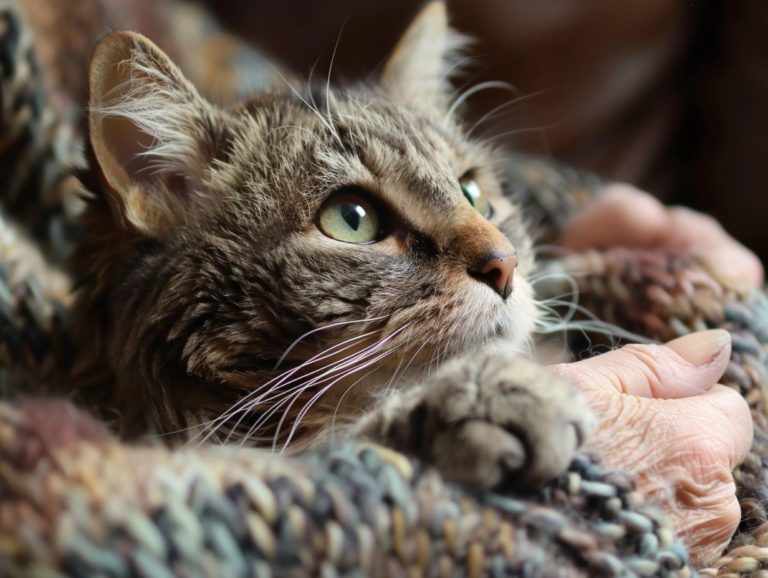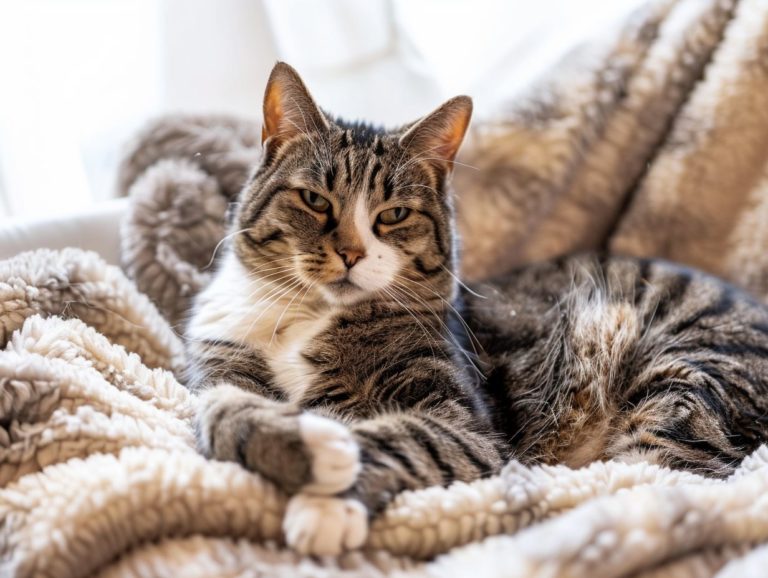How To File A Claim For Your Senior Cats Insurance Effectively
This article explores the topic of pet insurance for senior cats, covering aspects such as coverage, significance, and the process of filing a claim. It also offers guidance on submitting successful claims, common mistakes to avoid during the filing process, and how to address denied claims and coverage limitations. Pet insurance for senior cats holds importance as cats age since they are more susceptible to health issues, making their care increasingly costly to manage independently. Specialized pet insurance for senior cats is offered by numerous providers to ensure elderly felines receive appropriate care.
How Pet Insurance for Senior Cats Operates
The functioning of pet insurance for senior cats mirrors that of insurance for other age groups, although specific terms and particulars may vary. Pet insurance operates on the premise where the pet owner pays a monthly or annual premium, and in return, the insurance company covers a portion of the pet’s medical expenses.
Significance of Pet Insurance for Senior Cats
Ultimately, pet insurance plays a vital role in guaranteeing that elderly cats access adequate medical care. This becomes crucial for senior cats as they are more prone to age-related illnesses, leading to increased caregiving costs.
Filing a Claim for Pet Insurance for Senior Cats
The process of filing a claim for pet insurance for senior cats is akin to that of filing for cats of any age. When submitting a claim, it is generally advised to: promptly inform the insurance company of the pet’s condition, retain all medical records for the pet, preserve copies of veterinary bills, complete a claim form, and await processing. Upon approval, the insurance company will reimburse a portion or all of the pet’s medical expenses.
Tips for Successfully Filing a Claim for Pet Insurance for Senior Cats
To ensure a successful claims process, it is recommended to: fully comprehend the policy coverage, secure the cooperation of the veterinarian, provide comprehensive documentation, seek pre-approval for care, and promptly respond to any inquiries from the insurance company.
Common Challenges in Filing a Claim for Pet Insurance for Senior Cats
Common issues encountered when filing claims for pet insurance for senior cats include: incomplete information on the claim form, exclusion of the animal under the policy, pre-existing conditions, lack of diagnosis by a veterinarian, policy exclusions, reaching coverage caps, submitting claims post-policy cancellation or expiration.
Denial of Claims and Coverage Limitations with Pet Insurance for Senior Cats
Claims denials and coverage restrictions are typically due to factors such as the pet’s age, pre-existing conditions, insufficient documentation, and reduced coverage limits. To safeguard the health and well-being of senior cats, it is advisable to prepare for potential health concerns by investing in a pet insurance policy. Other measures include regular check-ups, vaccinations, a balanced diet, exercise, and ample affection for the feline companion.
Key Takeaways:
Understanding Pet Insurance for Senior Cats
The benefits of pet insurance for senior cats include coverage options designed for the specific needs of elderly cats, emphasizing the importance of securing adequate insurance against the health risks common in older cats.
As cats age, their chances of developing age-related medical conditions such as arthritis, kidney disease, and dental issues increase. These conditions may necessitate frequent veterinary visits, medications, and specialized treatments.
Comprehensive pet insurance is particularly crucial for senior cats as these conditions are often progressive and can deteriorate with age. Regular preventative care, encompassing annual check-ups, vaccinations, and dental cleaning, is essential in maintaining the health of older cats.
Tailored pet insurance coverage for senior cats considers these specific needs, providing peace of mind for owners and ensuring they can offer the best care for their pets as they enter their senior years.
What is Pet Insurance and How Does it Work?
Pet Insurance is a financial product that offers coverage for veterinary expenses, including routine check-ups, accidents, and illnesses. The process of how pet insurance works involves pet owners selecting a coverage plan, paying premiums, submitting claims for reimbursement, and insurers processing these claims in accordance with the policy’s terms and conditions.
Coverage options can vary from basic plans that include routine check-ups, vaccinations, and spaying/neutering to more comprehensive plans that encompass emergency surgeries, cancer treatments, and management of chronic conditions. When a claim is submitted, pet owners typically provide the necessary medical records, invoices, and receipts for the insurance company to assess.
The insurer will then determine the reimbursement amount, often calculated as a percentage of the total expenses incurred. Understanding the details of the policy is essential to ensure that pet owners can easily file claims and receive prompt reimbursement from their insurance provider.
Why is it Important for Senior Cats?
For senior cats, regular medical insurance is crucial as they often need more frequent vet visits to address and manage chronic conditions associated with old age. Comprehensive coverage is essential for senior cats for the same reason, providing timely medical care and treatment free of charge.
This type of insurance is important for senior cats as they typically require more frequent vet visits to monitor and manage chronic illnesses like cats health issues. Older cats are at a higher risk of developing more severe health issues, making it vital to have a safety net to cover unexpected medical expenses.
Annual coverage for senior cats enables owners to take a proactive approach in diagnosing and treating health issues early, ensuring they can offer the best possible care for their pets.
Steps to Filing a Claim
Filing a pet insurance claim involves collecting all necessary information and documentation, submitting the claim to the insurance provider with supporting medical records, and awaiting reimbursement according to the terms and coverage of the policy.
Accurate documentation is crucial in filing a pet insurance claim as it validates the medical necessity of the services provided to the insured pet. It is essential to retain all invoices, receipts, and reports from your veterinarian to support the right senior cat insurance policy claim.
Once you have gathered all the required information, promptly submit the claim to the insurance company. Timely submission plays a key role in expediting the reimbursement process. Upon submission, the insurance company will review the documentation and process the reimbursement based on the coverage details outlined in the policy.
Gather Necessary Information and Documents
- Claim form details: Complete the form accurately, specifying the treatment/service received, the date of service, the diagnosis, and details of the medication and/or procedure.
- Deductible details: Fill out this section on the form to understand the amount you must pay before the insurance coverage begins for eligible expenses.
- Waiting period details: Know the duration the pet owner must wait before the insurance policy covers the medical treatment. Some policies may have waiting periods for specific conditions even if no claim has been filed for that condition.
- Pet care medical records: Confirm that the pet’s medical records are current and that the treated medical condition is easily diagnosable and not considered a pre-existing condition.
- Preventive care documentation: Include vaccination records and/or receipts for approved medications or treatments.
Submit Claim to Insurance Provider
Upon completing the claim form and gathering all necessary information, the finalized claim form, along with supporting documents, is submitted to the insurance provider for their evaluation. The insurance provider will assess the claim in accordance with the policy’s annual coverage, covered procedures, and reimbursable expenses.
Some policies offer direct payment options for certain covered services, which can be advantageous for the policyholder. It is essential for the policyholder to be mindful of the annual coverage limits specified in their policy to ensure that the claim amount falls within the approved range.
Covered procedures may vary depending on the policy type, but commonly include medical consultations, prescription medications, diagnostic tests, hospital stays, and in some cases, emergency services, surgeries, specialist visits, and rehabilitation services, as outlined in the policy’s terms and conditions.
Tips for a Successful Claim
To ensure a successful pet insurance claim, it is essential to maintain comprehensive records of all medical expenses, keep a record of vet bills, understand and adhere to coverage limitations, and be prepared to challenge claim denials through the appeals process.
By documenting all medical expenses for your pet, you can demonstrate the necessity and reasonableness of each cost incurred during their treatment, providing concrete evidence to support your claims process and increase the likelihood of approval.
Understanding and respecting coverage limitations is key to setting realistic expectations and avoiding potential disputes. If there is a claim denial, it is crucial not to give up but to actively engage in the appeals process to present your case and potentially reverse the decision.
Keeping Track of Medical Expenses
It is essential to document pet care expenses, especially for veterinary visits, treatments, and medications, along with the corresponding medical records and invoices, to accurately submit insurance claims and receive timely reimbursement for any incurred costs.
When documenting medical expenses for your pet, creating a dedicated folder or digital file to store all invoices, receipts, and reports from medical visits consistently can be beneficial. Organizing information chronologically facilitates easy access to specific details.
Taking notes after visits regarding the diagnosis, treatment plans, and follow-up care advice can contribute to comprehensive documentation of your pet’s medical history. Keeping track of these expenses is valuable for monitoring your pet’s health progress and ensuring they receive appropriate care.
Following Up with Insurance Provider
After submitting a claim, it is recommended to follow up with the insurance company to monitor progress, address coverage-related questions, learn the appeals process for denied claims, and maintain open communication throughout the reimbursement process.
According to travel insurance marketplace Squaremouth, this follow-up is impactful because staying informed of the status of your claim can help to identify and address potential issues early. Asking questions about coverage can help travelers avoid misunderstandings and ensure they are making the most of their policy.
Understanding the appeals process in the event a claim is not approved is also important. This knowledge helps travelers know the steps required to successfully appeal their claim. Lastly, maintaining a dialogue with the insurance company helps to establish transparency and trust, which facilitates smoother claim resolution and a better overall customer experience.
Common Issues with Claim Filing
The claim filing process often presents challenges, with claim denials being the most common issue. To contest these denials, one must have a good understanding of the appeals process, which can help avoid such situations if coverage details and limitations are thoroughly known. It is crucial to comprehend the complexities of the pet insurance policy, particularly regarding conditions for claim denials, as many pet owners struggle to grasp the exclusions, pre-existing conditions, and schedule of benefits. Ensuring proper documentation and timely submission of claims can help prevent denials. Familiarizing oneself with the insurance company’s appeal procedures can offer a way to challenge unfavorable claim decisions and possibly secure the rightful coverage. Mastering these aspects is essential for successfully navigating the intricacies of pet insurance claim filing.
Denied Claims and How to Appeal
Understanding how to craft a pet insurance appeal is crucial in the event of a denial of your pet insurance claim. Start by identifying the reason for the denial, gathering additional evidence such as vet bills and medical records, and composing a comprehensive appeal to the insurance company to request a reevaluation of the decision and potentially reverse the denial.
Thoroughly examining the grounds for the initial denial allows for better clarification and justification in the appeal process. The appeal should provide detailed explanations, test results, and other pertinent information that supports the legitimacy and medical necessity of the claim. It is important to present a clear and concise narrative about the pet’s well-being and the essential nature of the medical procedure to facilitate understanding and processing by the insurer.
Backing up the appeal with relevant documentation not only validates the claim but also demonstrates the pet owner’s commitment and proactive approach to resolving the issue independently.
Understanding Coverage and Limitations
Understanding the details of coverage and limits outlined in a pet insurance policy is essential for policyholders to avoid issues when submitting a claim. This includes being aware of the waiting period, coverage for pre-existing medical conditions, the procedures covered, and how reimbursement for medical services functions.
Waiting periods: The waiting period in a pet insurance policy is the duration during which policy coverage becomes effective after purchasing the policy. Policyholders should be familiar with the waiting periods for different conditions and procedures.
Pre-existing conditions: Pre-existing medical conditions are health issues that existed before the pet was insured and are typically not covered. Therefore, understanding the policy’s stance on pre-existing conditions is crucial.
Knowing which procedures are covered: This ensures that you are financially prepared for potential medical costs.
Reimbursement of medical services: Understanding the reimbursement guidelines following a veterinary visit enables you to maximize your pet’s coverage.
Frequently Asked Questions
1. How do I file a claim for my senior cat’s insurance effectively?
To file a claim for your senior cat’s insurance, you will need to gather all necessary information and documents such as your pet’s medical records and the insurance policy. You can then fill out a claim form provided by your insurance company and submit it along with the required documents. Be sure to follow the instructions carefully and provide accurate information to ensure a smooth and efficient claim process.
2. What information do I need to provide when filing a claim for my senior cat’s insurance?
When filing a claim for your senior cat’s insurance, you will need to provide basic information such as your pet’s name, age, breed, and any pre-existing conditions. You will also need to include detailed information about the reason for the claim, including dates, symptoms, and diagnosis. Additionally, you may be asked to provide copies of medical records, invoices, and receipts for any treatments or medications.
3. Is there a specific time frame for filing a claim for my senior cat’s insurance?
Most insurance companies have a specific time frame for filing a claim, usually within 90 days from the date of treatment. It is important to check with your insurance provider to ensure you meet their deadlines. Failing to file a claim within the designated time frame may result in the claim being denied.
4. Can I file a claim for my senior cat’s insurance online?
Many insurance companies offer the convenience of filing a claim online. This allows you to submit all necessary information and documents electronically, saving you time and effort. However, some companies may still require you to mail in physical copies of documents, so be sure to check with your insurance provider.
5. How long does it take for a claim to be processed and approved?
The time it takes for a claim to be processed and approved can vary depending on the insurance company and the complexity of the claim. Generally, it can take anywhere from a few days to a few weeks. However, some companies offer expedited processing for urgent cases. It is best to check with your insurance provider for an estimated timeline.
6. What should I do if my claim for my senior cat’s insurance is denied?
If your claim is denied, do not panic. There may be a simple explanation or a chance to appeal the decision. First, carefully review the reason for the denial and gather any additional information or documents that may support your claim. You can then reach out to your insurance provider to discuss the denial and see if there is an appeal process available. If you are still unsatisfied with the outcome, you can also seek advice from a veterinarian or a pet insurance specialist.


